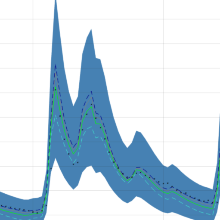Merging data-driven with physics-based modeling approaches, as targeted by the SimTech Cluster of Excellence, requires also merging on the level of statistical evaluation: we aim to fuse Bayesian uncertainty assessment with information-theoretic measures to bring (lack of) information in physics-based models and information in data to the same scale.
When assessing physics-based, data-driven and any hybrid modeling approaches within the same theoretically consistent frame, the identified gap in-between can ideally guide us toward model improvements with respect to both model accuracy and precision (two of the three vertices of the triangle worked on in PN 5). Diagnostic tools specifically tailored to the performance and potential of data-integrated simulation models are lacking to date, and we will close this gap by developing a suitable toolbox based on information-theoretic measures. This formal evaluation can be used as a basis for optimal design of experiments toward maximum-confident model selection under limited available data which integrates the third vertex and allows to enter the inner area of the triangle.
The formal fusion of model evaluation frameworks ties in perfectly with the goals of PN 6 to let physics-based models and machine learning benefit from each other and to melt them into a joint force. In more detail, we will exploit the interplay between visualization and model/system understanding (PN 6-3), because this avenue might help bringing the physics-based and the data-driven approaches conceptually closer together (and hence making them more comparable and interpretable). Further, uncertainty adds a dimension that typically spoils intuitive communication of model results, and smarter visualization techniques tailored towards data-integrated modeling can help increase the utility of such simulation outputs for decision-makers – an important step to transfer innovative science into practice.
As demonstration examples, we work on various types of hydrosystem models (relevant to the Cluster’s visionary example of engineered geosystems) through existing collaborations with the Institute for Modelling Hydraulic and Environmental Systems at the University of Stuttgart, with the Karlsruhe Institute for Technology (KIT), as well as with other German and international research groups. Further, we apply the newly derived concepts to data-integrated simulation models from PN 2 “Coupled Biological Systems”.
Our mission is to set new standards in data-integrated simulation model assessment which are expected to enable innovations of substantial societal impact.


